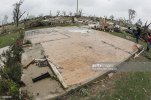Scouring and debarking/denuding are (at least partially) functions of debris loading. Outside of crop fields and such, you'll notice that most severe vegetation damage tends to occur in proximity to or downstream from significant debris sources. It wouldn't necessarily be surprising to see a strong or violent tornado in an open area not produce the kind of high-end vegetation damage we might otherwise expect. You'd normally see uprooted (and occasionally lofted) trees at least, but even that isn't 100% guaranteed.
Vehicle damage is kinda weird, too. For instance,
this study found that significant lofting/rolling of vehicles should be common at EF4+ intensity, yet field observations show only about 15% of vehicles in the paths of such tornadoes are actually flipped or thrown. In fact, around 36% of vehicles didn't move at all. Conversely, even EF1-EF2 tornadoes can very occasionally (~4% of the time) roll or loft vehicles.
In both cases, there are probably a ton of factors at work. The structure of a tornado is incredibly complex and ever-changing, so things like vertical velocity, gust factor, pressure forces, etc. can vary enormously even over incredibly short distances and timespans.
Also, re: winds in violent tornadoes being underestimated, there are a bunch of papers out there on different approaches to simulating tornadoes. It's a fascinating subject, and several of the simulations have exceeded anything we've actually observed. For instance, depending on the swirl ratio, some of the tornadoes in
this simulation produced absolutely insane velocities. In one instance, both horizontal
and vertical max gusts exceeded 400 mph.
Of course, it's important to remember these are idealized simulations and they don't take into account debris loading and other important factors. They almost certainly don't reflect anything you'd actually see in reality. Still, I think it lends some credence to the idea that we may be underestimating the maximum intensity of the most violent tornadoes.








































